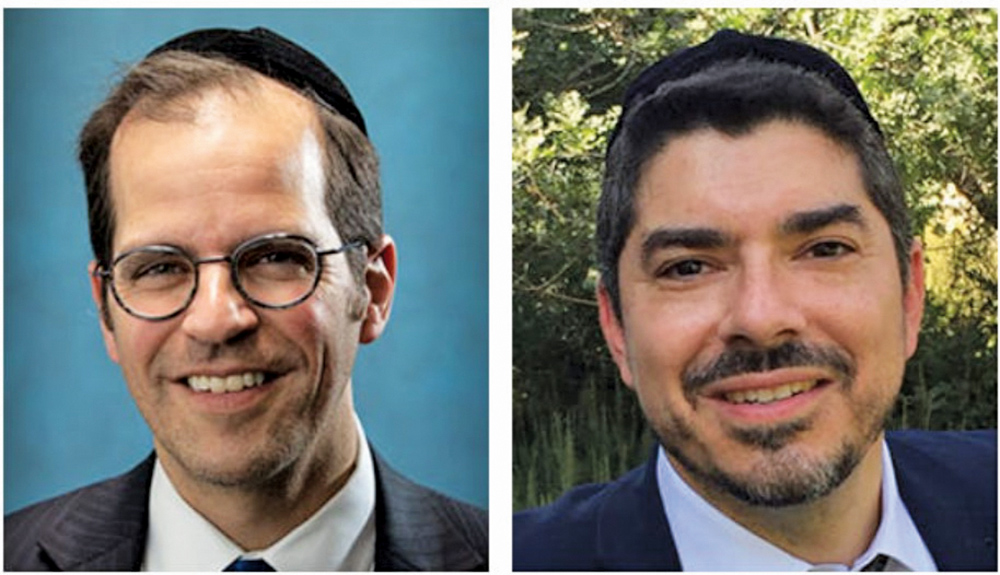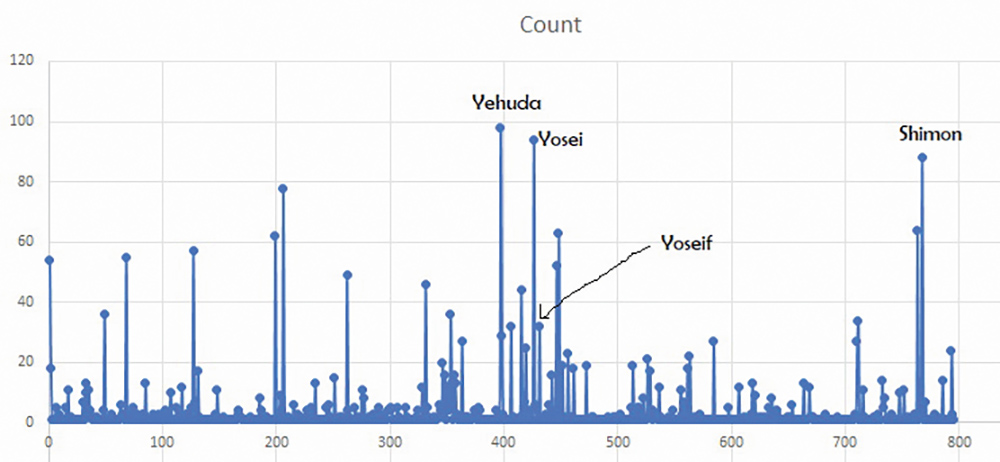By Rabbi Dr. Joshua Waxman

A common theme in this column is that two people can have the same name, and we need to disambiguate between them. For instance, Shmuel’s King Shapur is different from Rava’s King Shapur. We need to distinguish between the Amora Rabbi Eleazar (ben Pedat) and the Tanna Rabbi Eleazar (ben Shamua). There were five Rav Kahanas. This extends even to today.
On my blog, particularly when someone felt my thoughts weren’t frum enough, a commenter would often conduct a Google search and discover the existence of Rabbi Joshua Waxman—the Reconstructionist rabbi currently leading Temple Beth Rishon in Fair Lawn—and conflate us. A while back, on Nazir 66, the maggid shiur channeled a lot of material from Rabbi Aryeh Lebowitz’s (left) Daf Yomi shiur, so I tried looking it up on YUTorah. But alas, I misspelled his last name, and only saw shiurim from Rabbi Aryeh Leibowitz (right). What are the odds that there would be two Rabbi Aryeh Le(i)bowitzes hosted on the same website? It is like having two Yosef ben Shimons in the same town!
In Gittin 33b, we hear of Perata ben Rabbi Eliezer and ben Rabbi Perata the Great. This Perata also had a son, Rabbi Eliezer. Assuming they stayed local, there can be two Eliezer ben Peratas in the same town. How common is that? Need we be concerned in terms of Gittin?

The Mishnah on Gittin 27a discusses an agent for get delivery1 who lost the get and, subsequently, found it—either immediately or after a time. The Talmudic narrator explains the concern is for two men named Yosef ben Shimon in that town. This Yosef ben Shimon case first appears in the mishna in Bava Batra 167b about a promissory note, but Amoraim also discuss the case—Rabbi Yirmeya on Gittin 27b; and Abaye and Rava on 24b about promissory notes, prompted by a mishna about a man with two wives—each with the same name—where he directed the sofer with intent for the other wife.
Name Prevalence
Why, specifically, Yosef ben Shimon? Perhaps, because these are exceptionally common names in Tannaitic and Amoraic times. Because we do Torah UMadda at Yeshiva University, I decided to explore this name prevalence using Excel.
Dr. Michael Satlow has a list of Talmudic rabbis in Excel format2 as enumerated in Rav Aharon Hyman’s “Toledot Tannaim vaAmoraim,” and I worked off a more advanced version of that spreadsheet. Titles appear in column B, and the rest of their names in column D. I then wrote an Excel formula in column M to extract just the first name: =IFERROR(LEFT(D2,FIND(“ “,D2)-1),D2). So, Eleazar ben Pedat would become simply “Eleazar.” I then copied that list to another range in column O, eliminated duplicates, and created a table in which each name was paired with its frequency in the original list. Thus, in column P: =COUNTIF($M$2:$M$2996, O2). I then created a scatter chart showing first name frequency.
There are 2996 total rows, corresponding to approximately that number of Sages. There were about 795 unique first names. If there were a uniform distribution of first names, we’d expect that each first name would appear about 3.75 times. In fact, most names appear infrequently. Pappi and Matya only appear once. Some names appear more frequently, so Nachman appears 22 times. And some names appear much more frequently. In the image, Yehuda appears 98 times. Yosei appears 94 times, but it is a shortened form of Yosef which appears an additional 32 times. Shimon appears 88 times. This is a noisy list, because we aren’t examining father’s names in patronymics, nor all name variants—like Shemen and Simon for Shimon.
There actually are a few Yosef ben Shimons among the Sages. There is an Israeli Amora, Rabbi Yossi beRabbi Simon, a Rabbi Yossi ben Shimon who is a Tanna, and a first-generation Amora, Rabbi Yossi beRabbi Eleazar beRabbi Shimon.
Intuitively, in seeking a sample name of duplicate people in a single town, Chazal would use more common names like “Yosef” and “Shimon.” We might then wonder about intermediate level names like “Nachman,” or infrequent names like “Safra.” Would the relative infrequency turn the existence into a siman beinoni or siman muvhak, as discussed later on the page? Say that P(name) is the probability of a person’s name, taken as count(name) / count(all names). Then, the joint probability of the two names, P(son’s name, father’s name), would be something akin to the product, that is P(son’s name) x P(father’s name), ignoring that they appear in a particular order. For instance P(Yosei) = 95/2996, and P(Shimon) = 88/2996, and the product may be within reasonable chance. (Consider that we’d also have the wife’s two associated names.) Meanwhile, P(Matya) = 1/2996 and P(Symmachus) = 1/2996, so that product will be vanishingly small. Shouldn’t that be a siman muvhak?
This also makes a simplifying but incorrect assumption of independence of the two variables, the son and father’s name. Another simplifying and incorrect assumption is that names don’t cluster geographically. But, perhaps, people from Crown Heights will be more likely named “Menachem,” and people from Williamsburg will be more likely named “Yoely.”
Holes in a Get
In discussing relative levels of simanim, distinguishing marks for a lost get, Rav Ashi mentions the siman of a hole next to one of the letters—which would be a siman muvhak—a clearly distinguishing mark by which one can biblically return the get. Lesser level simanim would be that there is a hole somewhere in the get. If one said that paper/parchment of the get was long or short, that wouldn’t be valid, since there are many such long or short Gittin. Thus, we, again, get into probabilities.
We could count the number of letters in a typical get and then 1/count (letters) would be the probability of selecting that letter at random. Tell me, you’ve studied Gittin for several weeks already. Have you seen a sample get? I’d encourage you to perform a Google image search for גט אשה. Figure 3 is a get pulled from a Sefaria source sheet. I also copied a sample get of Rav Kook, applied OCR and counted 532 characters, so the probability is about 1/532—depending on name length, nicknames, etc.
Rav Schachter mentioned in a shiur that the practice, nowadays, when sending a get across country, is to appoint the shaliach by phone and send to get via post office—rather than buying an expensive airplane ticket. To ensure that it is the same get, they apply Rav Ashi’s hole trick. However, to further ensure its integrity, they select three random lines and place a hole in a random letter on each line. Now, there are 12 lines in a get, associated with the gematria of גט. Mathematically—n choose k—meaning selecting k (3) lines from n (12) choices is computed as (n!) / (n-k!)(k!), where the exclamation mark indicates factorial. This works out to 220 unique line selections. However, we also select a random letter on each of those lines. Assuming about 40 letters per line, the result is 220 x 40 x 40 x 40=14,080,000 unique combinations. That is certainly a siman muvhak!
Rabbi Dr. Joshua Waxman teaches computer science at Stern College for Women, and his research includes programmatically finding scholars and scholastic relationships in the Babylonian Talmud.
1 Not to be confused with Gett Delivery, a recent service available in the Israeli Uber-like app.
2 https://mlsatlow.com/2017/08/08/naming-rabbis-a-digital-list/









